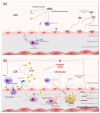Obstructive Sleep Apnoea and Lipid Metabolism: The Summary of Evidence and Future Perspectives in the Pathophysiology of OSA-Associated Dyslipidaemia
- PMID: 36359273
- PMCID: PMC9687681
- DOI: 10.3390/biomedicines10112754
Obstructive Sleep Apnoea and Lipid Metabolism: The Summary of Evidence and Future Perspectives in the Pathophysiology of OSA-Associated Dyslipidaemia
Abstract
Obstructive sleep apnoea (OSA) is associated with cardiovascular and metabolic comorbidities, including hypertension, dyslipidaemia, insulin resistance and atherosclerosis. Strong evidence suggests that OSA is associated with an altered lipid profile including elevated levels of triglyceride-rich lipoproteins and decreased levels of high-density lipoprotein (HDL). Intermittent hypoxia; sleep fragmentation; and consequential surges in the sympathetic activity, enhanced oxidative stress and systemic inflammation are the postulated mechanisms leading to metabolic alterations in OSA. Although the exact mechanisms of OSA-associated dyslipidaemia have not been fully elucidated, three main points have been found to be impaired: activated lipolysis in the adipose tissue, decreased lipid clearance from the circulation and accelerated de novo lipid synthesis. This is further complicated by the oxidisation of atherogenic lipoproteins, adipose tissue dysfunction, hormonal changes, and the reduced function of HDL particles in OSA. In this comprehensive review, we summarise and critically evaluate the current evidence about the possible mechanisms involved in OSA-associated dyslipidaemia.
Keywords: OSA; dyslipidaemia; lipid; metabolic dysfunction; obstructive sleep apnoea.
Conflict of interest statement
The authors declare no conflict of interest.
Figures



Similar articles
-
Effect modification by gender of the influence of obstructive sleep apnoea characteristics on dyslipidaemia in China: a cross-sectional study.BMJ Open. 2019 Sep 4;9(9):e028509. doi: 10.1136/bmjopen-2018-028509. BMJ Open. 2019. PMID: 31488475 Free PMC article.
-
Adipose tissue in obesity and obstructive sleep apnoea.Eur Respir J. 2012 Mar;39(3):746-67. doi: 10.1183/09031936.00047010. Epub 2011 Sep 15. Eur Respir J. 2012. PMID: 21920888 Review.
-
Effects of apolipoprotein E genotype on serum lipids in obstructive sleep apnoea.Eur Respir J. 2014 Apr;43(4):1097-105. doi: 10.1183/09031936.00098513. Epub 2013 Nov 14. Eur Respir J. 2014. PMID: 24232699
-
Obstructive sleep apnoea and cardiovascular complications: perception versus knowledge.Clin Exp Pharmacol Physiol. 2012 Dec;39(12):995-1003. doi: 10.1111/1440-1681.12024. Clin Exp Pharmacol Physiol. 2012. PMID: 23082844 Review.
-
Therapy with noninvasive ventilation in patients with obstructive sleep apnoea: effects on atherogenic lipoprotein phenotype.Med Hypotheses. 2009 Sep;73(3):441-4. doi: 10.1016/j.mehy.2009.03.031. Epub 2009 Apr 26. Med Hypotheses. 2009. PMID: 19398168
Cited by
-
Association between non-high-density lipoprotein cholesterol to high-density lipoprotein cholesterol ratio (NHHR) and sleep disorders in US adults: NHANES 2005 to 2016.Medicine (Baltimore). 2024 Jun 28;103(26):e38748. doi: 10.1097/MD.0000000000038748. Medicine (Baltimore). 2024. PMID: 38941362 Free PMC article.
-
The association between cardiovascular health and obstructive sleep apnea symptoms: findings from NHANES.Front Cardiovasc Med. 2024 Dec 20;11:1466752. doi: 10.3389/fcvm.2024.1466752. eCollection 2024. Front Cardiovasc Med. 2024. PMID: 39759500 Free PMC article.
-
Time Spent with Saturation below 80% versus 90% in Patients with Obstructive Sleep Apnoea.J Clin Med. 2023 Jun 22;12(13):4205. doi: 10.3390/jcm12134205. J Clin Med. 2023. PMID: 37445240 Free PMC article.
-
Characteristics and clinical value of intestinal metabolites in 4 to 6-year-old children with OSAHS.BMC Pediatr. 2025 Mar 17;25(1):204. doi: 10.1186/s12887-025-05561-4. BMC Pediatr. 2025. PMID: 40091027 Free PMC article.
-
Exploring the pharmacological mechanisms for alleviating OSA: Adenosine A2A receptor downregulation of the PI3K/Akt/HIF‑1 pathway (Review).Biomed Rep. 2024 Nov 28;22(2):21. doi: 10.3892/br.2024.1899. eCollection 2025 Feb. Biomed Rep. 2024. PMID: 39720297 Free PMC article. Review.
References
-
- Mach F., Baigent C., Catapano A.L., Koskinas K.C., Casula M., Badimon L., Chapman M.J., De Backer G.G., Delgado V., Ference B.A., et al. 2019 ESC/EAS Guidelines for the management of dyslipidaemias: Lipid modification to reduce cardiovascular risk: The Task Force for the management of dyslipidaemias of the European Society of Cardiology (ESC) and European Atherosclerosis Society (EAS) Eur. Heart J. 2019;41:111–188. doi: 10.1093/eurheartj/ehz455. - DOI - PubMed
-
- Gündüz C., Basoglu O.K., Hedner J., Zou D., Bonsignore M.R., Hein H., Staats R., Pataka A., Barbe F., Sliwinski P., et al. Obstructive sleep apnoea independently predicts lipid levels: Data from the European Sleep Apnea Database. Respirology. 2018;23:1180–1189. doi: 10.1111/resp.13372. - DOI - PubMed
Publication types
LinkOut - more resources
Full Text Sources

